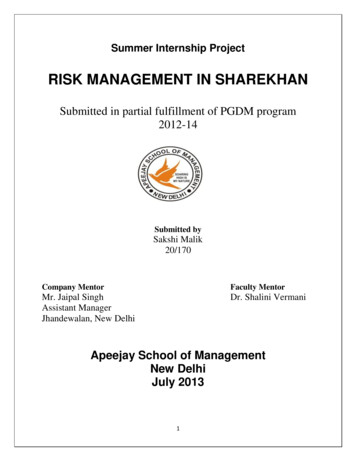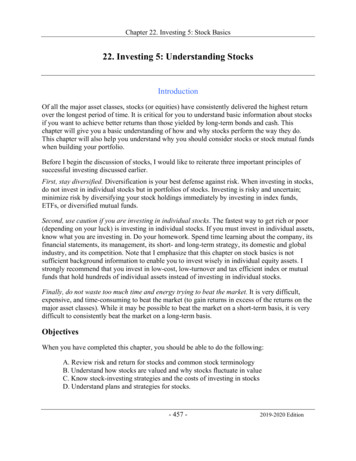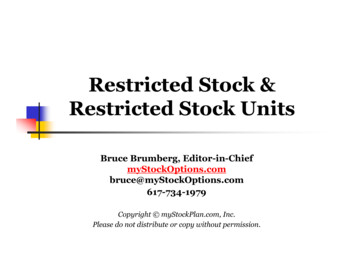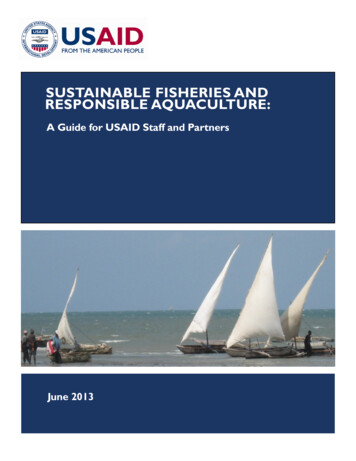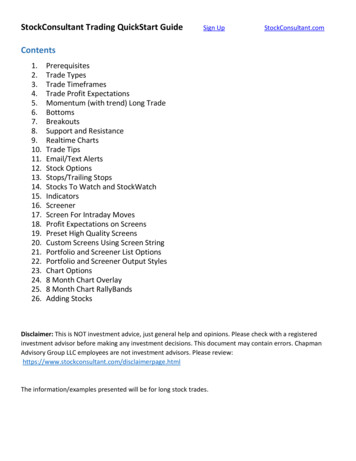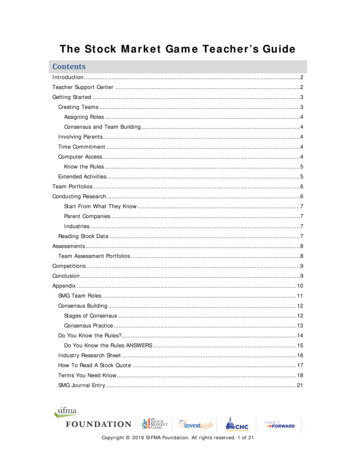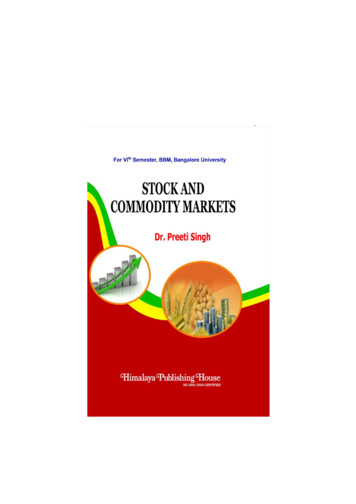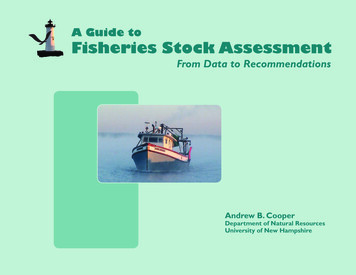
Transcription
A Guide toFisheries Stock AssessmentFrom Data to RecommendationsAndrew B. CooperDepartment of Natural ResourcesUniversity of New Hampshire
Fish are born, they grow, they reproduce and they die – whetherfrom natural causes or from fishing.That’s it. Modelers just usecomplicated (or not so complicated) math to iron out the details.
A Guide toFisheries Stock AssessmentFrom Data to RecommendationsAndrew B. CooperDepartment of Natural ResourcesUniversity of New HampshireEdited and designed by Kirsten WeirNH Sea Grant College ProgramKingman Farm, University of New HampshireDurham, NH 03824603.749.1565www.seagrant.unh.eduThis publication was supported by the National Sea GrantCollege Program of the US Department of Commerce’sNational Oceanic and Atmospheric Administration underNOAA grant #NA16RG1035. The views expressed herein donot necessarily reflect the views of any of those organizations.
AcknowledgementsFunding for this publication was provided by New Hampshire Sea Grant (NHSG) and the NortheastConsortium (NEC). Thanks go to Ann Bucklin, Brian Doyle and Jonathan Pennock of NHSG andto Troy Hartley of NEC for guidance, support and patience and to Kirsten Weir of NHSG for editing, graphics and layout. Thanks for reviews, comments and suggestions go to Kenneth Beal, retiredassistant director of state, federal & constituent programs, National Marine Fisheries Service; SteveCadrin, director of the NOAA/UMass Cooperative Marine Education and Research Program; DavidGoethel, commercial fisherman, Hampton, NH; Vincenzo Russo, commercial fisherman, Gloucester,MA; Domenic Sanfilippo, commercial fisherman, Gloucester, MA; Andy Rosenberg, UNH professorof natural resources; Lorelei Stevens, associate editor of Commercial Fisheries News; and Steve Adams,Rollie Barnaby, Pingguo He, Ken LaValley and Mark Wiley, all of NHSG. Photo credits: front cover,Pingguo He; back cover, Kirsten Weir.
Contents1 Stock Assessments: An Introduction. . . . . . . . . . . . . . . . . . . . . . . 52 What Types of Data are Available? . . . . . . . . . . . . . . . . . . . . . . . . 75 Applying Stock Assessment Models to Data. . . . . . . . . . . . . . . . 29Indices of Abundance . . . . . . . . . . . . . . . . . . . . . . . . . . . . . . . . 29Fishery-Dependent Data. . . . . . . . . . . . . . . . . . . . . . . . . . . . . . . 7Catch-per-Unit Effort . . . . . . . . . . . . . . . . . . . . . . . . . . . 30Landing Records . . . . . . . . . . . . . . . . . . . . . . . . . . . . . . . . 7Estimates of Actual Stock Size . . . . . . . . . . . . . . . . . . . . . 31Portside Sampling . . . . . . . . . . . . . . . . . . . . . . . . . . . . . . . 7Index-Only Models. . . . . . . . . . . . . . . . . . . . . . . . . . . . . . . . . . 31Onboard Observers . . . . . . . . . . . . . . . . . . . . . . . . . . . . . . 8Fitting Models to Data . . . . . . . . . . . . . . . . . . . . . . . . . . . . . . . 32Log Books and Vessel Trip Reports. . . . . . . . . . . . . . . . . . . 8Frequentist versus Bayesian Approaches. . . . . . . . . . . . . . 32Telephone Surveys. . . . . . . . . . . . . . . . . . . . . . . . . . . . . . . 8Biomass Dynamics Models – Theory. . . . . . . . . . . . . . . . 34Fishery-Independent Data. . . . . . . . . . . . . . . . . . . . . . . . . . . . . . 9Biomass Dynamics Models – Targets and thresholds . . . . 343 Biological Reference Points. . . . . . . . . . . . . . . . . . . . . . . . . . . . . 11Age-Structured Models – Theory. . . . . . . . . . . . . . . . . . . 35Targets versus Thresholds. . . . . . . . . . . . . . . . . . . . . . . . . . . . . 12Age-Structured Models – Targets and thresholds . . . . . . . 37Determining Thresholds. . . . . . . . . . . . . . . . . . . . . . . . . . . . . . 13Estimating Uncertainty . . . . . . . . . . . . . . . . . . . . . . . . . . 37Uncertainty. . . . . . . . . . . . . . . . . . . . . . . . . . . . . . . . . . . . . . . . 176 Making Recommendations. . . . . . . . . . . . . . . . . . . . . . . . . . . . . 394 Population Dynamics Models:The Underpinnings of Stock Assessment Models. . . . . . . . . . 21The Basic Population Dynamics Model. . . . . . . . . . . . . . . . . . . 21Adding Complexity: Mortality . . . . . . . . . . . . . . . . . . . . . . . . . 22Adding Complexity: Age Structure. . . . . . . . . . . . . . . . . . . . . . 23Adding Complexity: Stock-Recruitment Functions. . . . . . . . . . 26Adding Complexity: Weight and Biomass. . . . . . . . . . . . . . . . . 28Glossary. . . . . . . . . . . . . . . . . . . . . . . . . . . . . . . . . . . . . . . . . . . . 41
Stock Assessments:An Introduction1Fishery managers have a range of goals. Theystrive to maintain healthy fish populations anda healthy fishing industry while still preservingvital recreational communities. To achieve theirgoals, managers rely on a collection of tools,including quotas, size limits, gear restrictions,season timing and area closures. But how dodecision makers determine which combinationsof tools will best accomplish their objectives?To choose the best approach to managing a fishstock, managers must equip themselves with asmuch information as possible.A stock assessment provides decision makers with much of the information necessary tomake reasoned choices. A fishery stock assessment describes the past and current status of afish stock. How big is the stock? Is it growingin size or shrinking? A stock assessment also attempts to make predictions about how the stockwill respond to current and future managementoptions. Will a slight increase in fishing pressurehave a negative effect on the stock next year?Ten years from now? In the end, the managermust decide how to interpret the informationfrom the stock assessment and determine whichoptions are best overall.A complete stock assessment contains a vastarray of information on both the fish population and the fishery itself. A fish population isa group of individual fish of a single interbreeding species located in a given area, which couldbe as large as the Atlantic Ocean or as small asa single river. A fish stock, on the other hand,is defined as much by management concerns– such as jurisdictional boundaries or harvestinglocation – as by biology. For example, alewivesfrom the Taylor River are considered a separatepopulation from those in the Lamprey River,but both are part of the Gulf of Maine alewifestock.A stock assessment providesdecision makers with theinformation necessary tomake reasoned choices.Within a fish stock or population, a cohort is a group of fish all born in the sameyear. Within the Gulf of Maine cod stock, allof the cod born in 2004 belong to one cohortand those born in 2005 comprise a secondcohort. Stock assessments often track a cohortover time. Short-term increases or decreases inthe size of a particular stock can sometimes beexplained by the existence of an exceptionallylarge or small cohort.A stock assessment describes a range oflife history characteristics for a species, such as
information (derived from other studies) aboutage, growth, natural mortality, sexual maturityand reproduction; the geographical boundariesof the population and the stock; critical environmental factors affecting the stock; feedinghabits; and habitat preferences. Drawing on theknowledge of both fishermen and scientists,stock assessments give qualitative and quantitative descriptions of the fishery for a species, pastand present. Final stock assessment reports alsocontain all of the raw data used in the assessment and a description of the methods used tocollect that data.The mathematical and statistical techniquesused to perform a stock assessment are referredto as the assessment model. Scientists comparedifferent assumptions within a given assessmentmodel and may also examine a variety of different assessment models. Ultimately, stock assessment scientists will estimate the current statusof the stock relative to management targets andpredict the future status of the stock given arange of management options. They will alsodescribe the most likely outcomes of those options and the uncertainty around those outcomes. This publication is not designed to be anall-inclusive description of data and methodsused for stock assessments. Rather, the goal ofthis document is to provide an overview of howstock assessment scientists and managers turndata into recommendations. We assume readershave some working knowledge of the fisheriesmanagement process, but no modeling or statistics background is necessary.We’ll discuss the range of data that mightbe available to scientists and the types of information a stock assessment provides. We’llthen describe the range of population dynamics models (from the simple to the complex)that can underlie the assessment model. Finally,we will discuss how stock assessment scientistsmerge data and models to determine the statusof the stock and generate recommendations. Aglossary in the back of this publication definesthe technical terms associated with stockassessment science.Recommended ReadingOur goal is to provide readers witha basic understanding of the stockassessment process. For readerslooking for more detailed and technicaldescriptions of stock assessment modelsand their role in fisheries management, werecommend the following publications.Quantitative Fisheries StockAssessment: Choice, Dynamics,and Uncertainty, by Ray Hilbornand Carl J. Walters. Published byChampan and Hall, 1992.Quantitative Fish Dynamics,by Terrance J. Quinn and RichardB. Deriso. Published by OxfordUniversity Press, 1999.Fisheries Stock Assessment User’sManual, edited by Jeffery C. Burstand Laura G. Skrobe. Publishedas Special Report No. 69 by theAtlantic States Marine FisheriesCommission, 2000.
What Types of Dataare Available?2Data used in stock assessments can be categorized as either fishery-dependent or fisheryindependent. Fishery-dependent data arederived from the fishing process itself and arecollected through such avenues as self-reporting,onboard observers, portside surveys, telephonesurveys or vessel-monitoring systems.Fishery-independent data are derived fromactivities that do not involve the commercial orrecreational harvest of fish, such as trawl, acoustic, video and side-scan sonar research surveysand some tagging experiments. Stock assessments generally require data on catch, relativeabundance and the life history of the species inquestion. Both fishery-dependent and fisheryindependent data can help fulfill these needs.Fishery-Dependent DataLanding RecordsThe most common sources of fishery-dependentdata are landings records and port samples.Landing records, which result directly from thesale of caught fish, provide information only onlanded catch. The data is often in the form oftotal weight and rarely in total numbers of fish.When the market for a given species hasmultiple size categories, the landing recordscan give some coarse information on the sizedistribution of the catch, but such information is rarely precise enough to be used directlyin a stock assessment. Other forms of data arerequired to sort out these landing records intospecific size or age distributions.Portside SamplingSome portion of both recreational and commercial catch is sampled on the docks for size andage by government scientists known as portsideobservers or port agents. When the observersare sampling from recreational fishermen, thesurvey is called a creel survey. In sampling bothrecreational and commercial catch, the size ofa fish is measured on site. Determining a fish’sage, however, requires taking biological samplesto be evaluated in a lab. Scientists can determinea fish’s age by counting the growth rings in ascale or an otolith (ear bone), much likecounting the rings of a tree.Because a fish’s age must be determined ina lab, many more length samples are taken thanage samples. Scientists then estimate the lengthfrequency, or the total number of landed fish ineach length class. These estimates are calculatedfor each type of fishing gear separately, as eachgear may have its own length-frequencydistribution.For example, if 80 percent of the fishsampled from a gill net fall within a given size
range, it is assumed that 80 percent of the totalnumber of fish landed by that gill net fall withinthis size range. But gill nets with larger orsmaller mesh sizes would have their own lengthfrequency distributions. If length-samplingdata is sparse, though, scientists may not haveenough information to reliably estimate thelength distribution.By taking both size and age samples from anumber of individual fish, scientists can determine how to estimate the age of a fish based onits length. Fisheries scientists use these estimatesto develop a length-age table, or length-agekey. This table allows a stock assessment scientistto convert the length distribution of the landedcatch (which is based on many, many samples)into an age distribution of the landed catch.Onboard ObserversTo gain a broader understanding of the waysin which commercial fishermen interact with arange of species, government personnel knownas onboard observers sometimes accompanyfishing vessels. Observers are trained to samplecatch for size, and sometimes age, and to estimate bycatch and discards. Bycatch are the fish caught during the fishing process that were not specifically targeted forharvest. Not all bycatch is discarded. Some bycatch is landed and recorded by landing recordsor portside observers. Bycatch that are thrownback (because they were the wrong size, sex orspecies, or because trip limits or quotas weremet) are called discards. All discards are a formof bycatch. Only a portion of the discardedbycatch will survive the catch and discarding process, which means that the estimate oflanded catch will underestimate, sometimesquite severely, the total amount of fishingrelated mortality.Usually only a portion of the vessels in afishery carry onboard observers. To generate afleet-wide estimate of discards, scientists assumethat the unobserved vessels behave in the samefashion as the observed vessels. Scientists oftencalculate the length-frequency distribution ofthe discards, which allows them to estimatethe number of fish discarded for each lengthclass for the entire fleet. Drawing on length-ageAny fish caughtthat were not specificallytargeted for harvest arecalled bycatch. Bycatch thatare thrown back are knownas discards.tables, scientists can then estimate the numberof discards in each age class.In the absence of onboard observers, scientists are forced to make assumptions abouthow many fish are discarded. They often set theamount of discards equal to some proportionof the landed catch, based on previous research.Scientists also refer to previous research toestimate the discard mortality (the rate at whichthe discarded fish die.)Log Books and Vessel Trip ReportsIn some commercial fisheries, either as arequirement or as an organized voluntary effort,fishermen keep their own records, called logbooks or vessel trip reports, which they pass onto government officials. Data from landing records and onboard observers are generally considered more reliable than log books in termsof estimating landed total weight and numbers.Nevertheless, the log books can be incrediblyvaluable for determining the spatial distributionand amount of effort in the fishery. In somefisheries, boats also use electronic devices thatautomatically record the location of avessel, called vessel monitoring systems.Telephone SurveysThe primary method for collecting data onrecreational fisheries is through a telephonesurvey conducted as part of the National MarineFisheries Service’s Marine Recreational FisheryStatistics Survey (MRFSS). Scientists use this
survey to estimate the number of recreationalfishing trips that target a specific species andthose that merely encounter a specific species,even if that species isn’t targeted.Each fish encountered during a trip fallsinto one of three categories: caught and sampledby portside observers (labeled type A fish),caught but not sampled by portside observers(type B1 fish), or caught but thrown back (typeB2 fish). An estimated percentage of type B2fish is assumed to die as a result of the catchand-release process, based on information fromother studies.For the purposes of stock assessment, thetotal mortality associated with the recreationalfishery equals all the fish caught and sampledby portside observers, all the fish caught andnot sampled, and an estimated portion of thefish that were thrown back. Scientists take thesurvey data and estimate the number of fishcaught in each length class by applying thelength-frequency data from portside sampling tothe estimated total number of fish caught.Fishery-Independent DataThe vast majority of fishery-independent datacomes from research surveys conducted by thefederal or state governments. Scientists takesamples throughout the potential range of thetarget fish using standardized sampling gear including trawls, seines, hydroacoustics and video.These surveys can target a group of severalspecies (such as the Northeast Fisheries ScienceCenter bottom trawl survey), a single species(such as the Northeast Fisheries Science Centerherring survey), or even a specific age-class of aspecific species (such as beach seine surveys foryoung-of-the-year bluefish).Survey data provide anindex of fish abundance aswell as information aboutsize, age and maturity ofthe fish in the stock.Results from tagging, mark-and-recaptureand other studies typically fall under the category of fishery-independent data. Such studiesmay estimate the movement or migration ratesbetween stocks, the natural mortality rate of thefish, the reproductive output of the fish, growthrates, maturity schedules (the percent of individuals mature at each age), and hooking or discardmortality rates. All of this information enhancesstock assessment models.Regardless of the target or the gear, maintaining standard survey practices over time iscrucial. Changes in mesh size, soak times andtow length or speed can all impact the comparability of a survey over time. Whenever new gearor sampling methods are adopted, they shouldbe calibrated so that results can be directly compared to results from the old gear or method. Bysampling across the potential range of the fish,rather than just its current range, the survey candetect shifts in distribution, including rangecontraction or expansion.The survey data provide an index of fishabundance, typically the number of fish caughtper unit of effort (such as the number of fish pertow). Surveys can also provide information onthe size and age distributions of the stock, estimates of the percentage of fish mature at eachage, and size-age relationships (similar to thosederived from portside or onboard observationof the catch). By sampling stomach contents,survey scientists can even determine a species’diet.
10
BiologicalReference Points3Through stock assessments, scientists attempt toestimate the amount of fish in a stock and therate of fishing mortality. They do so with regardto a stock’s biological reference points. Abiological reference point is a concrete number,a value for, say, stock size or fishing mortality. Astock assessment produces a series of estimatesfor stock size and fishing mortality over time.Biological reference points serve as a way tojudge those estimates based on knowledge andassumptions about the species’ growth, reproduction and mortality.Biological reference points give decisionmakers guidance in determining whether populations are too small or fishing pressure is toogreat. They help provide targets for how largethe population or how intense the fishingpressure should be.Why do we care about the fishing mortality rate? In its simplest form, the fishing mortality rate is the rate at which fish are removedfrom the stock by harvesting. Think of a fishstock as money in an interest-bearing bank account. If the interest is five percent per year, thebank account balance will grow as long as youwithdraw less than five percent per year. If youwithdraw more than five percent per year, thebank principal will decrease. If you do that consistently, you’ll eventually empty the account.The interest rate in this example is equivalent to the stock’s growth rate. The withdrawalrate is equivalent to the fishing mortality rate.Biological reference points based on fishingmortality help managers keep the withdrawalrate at a level that will ensure the long-termproduction or stability of the stock.The concept of maximum sustainable yield(MSY) serves as the foundation for most biological reference points. The maximum sustainableyield is typically thought of as the largestaverage catch that can be continuously takenfrom a stock under existing environmentalconditions. That is, maximum sustainable yieldis the greatest number of fish that can be caughteach year without impacting the long-termproductivity of the stock.Stock assessment scientists and decisionmakers use the letter B to denote biomass, thetotal weight of the fish in a given stock. Occasionally, rather than total biomass, scientistswill refer to the spawning stock biomass (SSB),the total weight of the reproductively matureindividuals in the stock. The term BMSY is usedto indicate the stock size that can produce themaximum sustainable yield. The term SSBMSYindicates the size of the reproductive matureportion of the stock that will produce themaximum sustainable yield. Similarly, the letterF denotes the fishing mortality rate, while FMSYindicates the fishing mortality rate at the levelthat would maintain the maximum sustainableyield for a stock at BMSY.11
Fisheries scientists aim to determine a stock’soptimum yield, the amount of catch that willprovide the greatest overall long-term benefitto society. The optimum yield must take intoaccount the biology inherent in maximumsustainable yield, as well as economics and theattitudes of the public towards risk and environmental protection. The optimum yield cannever be greater than maximum sustainableyield. In some cases scientists may set optimumyield equal to maximum sustainable yield, butthey often set it at a value less than maximumsustainable yield.In theory, if the environment is constanta fishery should be able to produce an averagecatch equal to maximum sustainable yield foreternity. By environment we mean everythingfrom water temperature and habitat composition to predator and prey abundance –anything that affects the birth, growth or deathrates of a fish. That’s a pretty tall order.The environment is anything but constantand the ability of fisheries managers to controlharvest from year to year can, in some situations, be quite shaky. Despite this, the conceptof maximum sustainable yield serves as the underpinning for many of the biological referencepoints that are evaluated in a stock assessment.Targets versus ThresholdsBiological reference points provide quantitativevalues for targets and thresholds. Targets arevalues for stock size and fishing mortality ratethat a manager aims to achieve and maintain.Targets are determined by a combination of12biological and socioeconomic factors. This iswhere optimum yield comes into play. Shouldthe population target be BMSY or somethinglarger than BMSY? Should the target fishing mortality rate be FMSY or something lower? Shouldthe target fishing mortality rate be managedto provide for a relatively constant catch? Orshould it allow for a relatively constant effort,within an acceptable range of fishing mortalityrates?Targets are stock size andfishing mortality levelsthat managers aim toachieve and maintain.Thresholds are levels theywish to avoid.Deviations from the targets may or maynot result in changes in policy. Control rules,designed by scientists but chosen by managers,guide the ways in which the fishing mortalityrates are adjusted over time based on the statusof the stock.While targets are levels that managers aimfor, thresholds are levels they aim to avoid.Thresholds are also referred to as limits, especially in the realm of international fisheriespolicy. A threshold is often defined as a specificfishing mortality rate or stock size that is somefraction of BMSY. Consider again the bank account example described earlier. If you beginto withdraw more money than your accountis earning through interest, you’ve crossed athreshold. When a fishery crosses a threshold,the stock is being depleted too quickly and actions must be taken to correct the situation.Two of the key questions that a stock assessment aims to address are whether overfishing is occurring and whether the stock is in anoverfished state. Although they sound similar,they are actually two distinct concepts. Overfishing occurs when the fishing mortality rateexceeds a specific threshold. The stock is beingdepleted too quickly, but the stock size may stillbe fairly large. Conversely, a stock is determinedto be overfished when stock size falls below aspecific threshold, either in terms of numbers orbiomass of fish.A stock may fall into any of four categorieswith regard to overfishing and being in anoverfished state. (See Overfished or Overfishing? page 13.) In 2004, for example, the fishingmortality rate for Georges Bank Atlantic codwas determined to be greater than the fishingmortality threshold. The same year, the spawning stock biomass for Georges Bank Atlanticcod fell well below the spawning stock biomassthreshold. In other words, overfishing wasoccurring and the stock was overfished.
Overfished or Overfishing?Stock assessments attempt, in part, to determine whether overfishing is occurring and whethera stock is in an overfished state. While the two concepts are obviously related, they are notidentical. Overfishing occurs when the fishing mortality rate (F) is greater than the fishingmortality threshold (Fthreshold). A stock is overfished when the stock size (B) falls below thestock size threshold (Bthreshold). Fish stocks fall into one of four categories based on theseprinciples.If a stock is overfished, or if overfishingis occurring, managers are required by law toput measures in place to correct the situation.While the stock assessment produces estimatesof the fishing mortality rate and stock size, thechoice of thresholds is dictated by governmentpolicy. In the case of federally managed species,the policies are known as the National Standard Guidelines. These policies have evolvedover time and have involved a fair bit of debatebetween scientists.Determining ThresholdsB BthresholdFFthresholdF FthresholdBBthresholdStock is overfished&Overfishing is occuringStock is not overfishedbutOverfishing is occuringStock is overfishedbutOverfishing is notoccuringStock is not overfished&Overfishing is notoccuringIn order to manage a stock, decision makersmust define a stock size threshold (Bthreshold),also called a minimum stock size threshold.As discussed previously, the stock size thatcan produce the maximum sustainable yield isknown as BMSY. The stock size threshold can bedefined in one of two ways, both of which arerelative to BMSY. The stock size threshold may bedefined simply as a percentage of BMSY – typically half (but never less than half ) of BMSY. Alternatively, the stock size threshold can be definedas the smallest stock size that could grow to BMSYin 10 years if the fishing mortality rate was aslow as possible (which might not be zero, depending on fishermen’s ability to avoid bycatch).Current law requires the stock size threshold tobe set equal to the larger of these estimates.Determining the fishing mortality threshold (Fthreshold), or maximum fishing mortalitythreshold, is a much more complicated matter than determining the stock size threshold.Because managers attempt to keep the stock at13
or above BMSY, the fishing mortality thresholdshould be less than the fishing mortality thatwould produce BMSY – that is, less than FMSY.Given that the estimate for natural mortality (M) is an upper limit for FMSY, the fishingmortality threshold for many fish stocks shouldalso be less than the natural mortality rate. Howmuch less is a function of the reproductive capacity of the stock.A variety of methods exist to estimate fishing mortality thresholds. Some fishing mortality thresholds are based on “yield-per-recruit”analyses, where yield is the expected weight offish caught by the fishery and recruits are fish atthe youngest age entering the fishery. Yield-perrecruit analyses are performed in the last stagesof the stock assessment and will be discussed ingreater detail later.Yield per recruit depends on the growthrates of individual fish, natural mortality andfishing mortality. In the simplest sense, if itwas possible to catch fish of just one optimalage, one would maximize the yield per recruit14by catching all fish at exactly that age, whenthe percentage of fish dying of natural causesequaled the percent weight gained by the fish.For example, if 10 percent of a cohort ofequally sized fish will die due to natural causesbetween now and next fishing season, but thecohort will increase in weight by 15 percentduring that same time period, then this cohort will still be five percent larger, in terms ofweight, next year. Ignoring changes in price andthe value of a dollar today versus a dollar tomorrow, one would be better off waiting to fish thecohort next year.The yield per recruit (the total weight of fishcaught divided by the number of fish from thatcohort that originally entered the stock) wouldincrease over the year, and fishermen wouldget a higher yield by waiting. But if the cohortwould only increase in weight by 10 percent,a fisherman would get the same yield this year,in terms of weight, as he or she would the nextyear. If the cohort only increased in weightby eight percent, it would have a smaller totalweight next year
stock. Within a fish stock or population, a co-hort is a group of fish all born in the same year. Within the Gulf of Maine cod stock, all of the cod born in 2004 belong to one cohort and those born in 2005 comprise a second cohort. Stock assessments often track



